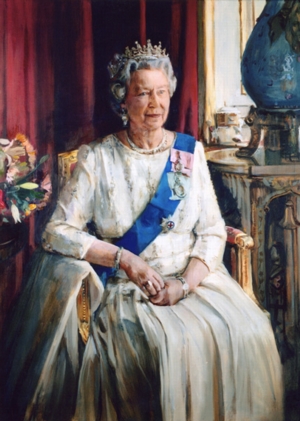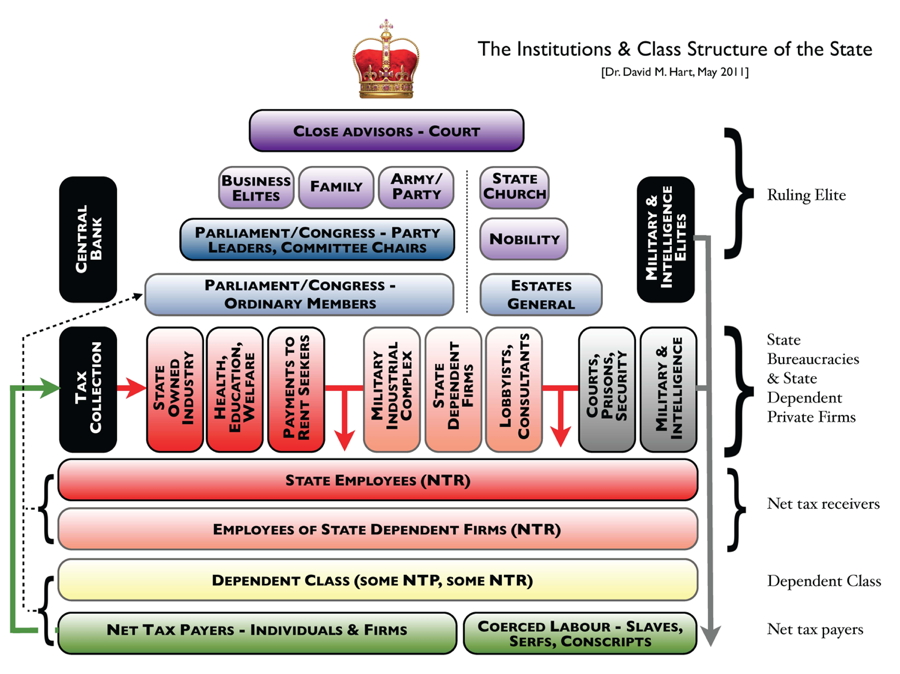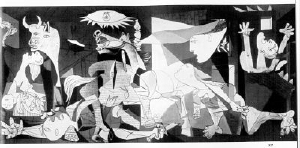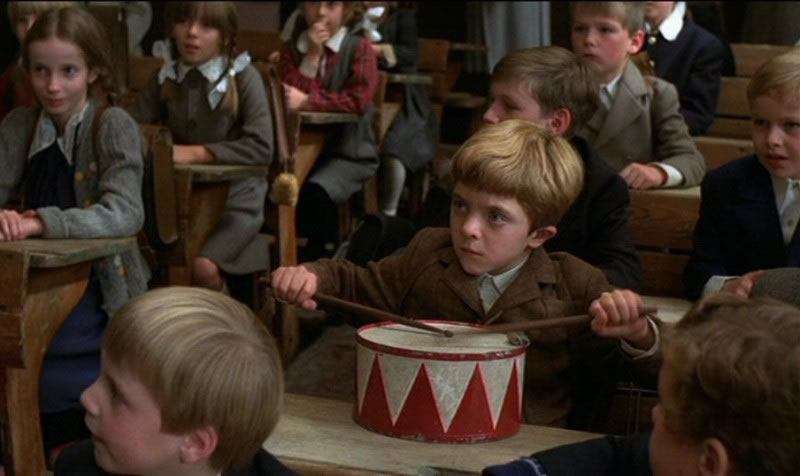
INSTITUTE FOR HUMANE STUDIES
"Liberty and Society" Summer SEMINARs 2012
[Updated: July 21, 2022]
 |
Eugène Delacroix, "Liberty Leading the People on the Barricades"
(1830) |
David Hart's lecture summaries, handouts and overheads, and recommended readings:
- The State and the Ruling Class
- War and the Growth of the State
- The Culture of Liberty vs. the Culture of Authority and Obedience
The video clips I use in the lectures are collected at this page.
1. The State and the Ruling Class
- Lecture Slide Show
- [see selection of images on my blog]
- PDF version (single file) [PDF 8.9 MB]
- HTML version (click on the slide to advance to the next one)
- Other Lecture Material
- Video clips
- Terry Gilliam and Terry Jones, Monty Python and the Holy Grail (1975) - "the constitutional peasants"
- Additional material:
- A more detailed bibliography [PDF] [HTML]
- A collection of quotations about class and the State
- A summary page of my thoughts on the topic
- A collection of caricatures and images of the Ruling Class
 |
James Gillray, "The British Atlas, or John Bull supporting
the Peace Establishment (1816) |
Questions to Consider.
The State:
- what is the State and how does it function?
- who controls it?
- why has it grown so much over the past 100 years? & where is it heading now?
- is there an optimal size of the State & can it be limited to just these powers?
The Ruling Class:
- who has access to State power & what do they do with this power?
- what are the key power centres & who controls them?
- who benefits from this control (cui bono?) & what are these benefits?
- who pays for this?
- if the same group/s who benefit from State power persist over time, can we call them a “ruling class”?
- if the number of people who benefit from State power come to exceed the number who pay for it, how (in a democracy) can we ever return to a free society?
Key Recommended Reading & Films:
Murray Rothbard, "The Anatomy of the State" in Egalitarianism as a Revolt against Nature (2nd ed. Ludwig von Mises Institute, 2000). Online at the Mises Institute <http://mises.org/easaran/chap3.asp>.
Frédéric Bastiat, “The Physiology of Plunder,” in Economic Sophisms,
trans. Arthur Goddard (Irvington-on-Hudson: Foundation for Economic Education,
1968), pp. 129-46. Online at the Online Library of Liberty <http://oll.libertyfund.org/title/276/23376>.
David Hart’s “Schematic Diagram showing the Institutions and Class Structure of the State” <http://davidmhart.com/Guides/ClassTheory/ClassStructure-details%20/index.html>.
Film: See the clip from Terry Gilliam and Terry Jones, Monty Python and the Holy Grail (1975) on “The Constitutional Peasants” on my website <http://davidmhart.com/VideoClips/index.html>.
Images: See the collection of “Images of The Ruled as Atlas” on my website <http://davidmhart.com/Guides/ClassTheory/Atlas.html>.
Images: See some of my “Images of the Ruling Class” on my website <http://davidmhart.com/Guides/ClassTheory/ImagesOfRulingClass.html>.
Key Points
The Main Features of the State:
- the State has a monopoly of the use of force
- the State claims it has the sole legitimacy to exercise this force
- the State claims a monopoly in key sectors of the economy
- the State claims that different standard of morality applies to its actions
- the State needs obedient & compliant taxpayers & citizens who will “Obey & Pay”
- the State has an historical tendency to expand its powers
The Main Features of the Ruling Class:
- the Ruling Elite (RE) has privileged access to the key power centres of the state
- the RE can use this power to its own advantage (exclude rivals, protect allies, garner benefits)
- the RE uses state power to acquire benefits for itself such as wealth, status, & privilege, & to dispense benefits to its allies, clients, & favourites
- The State divides Society into two Rival Groups or Classes - the “net tax payers” (the ruled) and the “net tax receivers” (the ruling class)
- the State creates a “dependent class” which is reliant upon continued State benefits & which votes to maintain this
- The Sovereign Power makes Constantly Shifting Alliances with Vested Interests who are political “rent-seekers”
- Legislation socializes Costs and Privatizes Benefits for Favoured Groups
The Dynamic of the Growth of State Power & Class Rule:
- There are “dynamic” processes at work which tend to increase the power of the State over time.
- They indicate an instability or problem which needs to be solved.
- When the vested interests of ruling elites are combined with an ideology which favours government intervention these dynamics produce greater government intervention in economy/society.
- the dynamics of the growth of the State:
- Dynamic of Increasing Class Conflict
- Democratic Dynamic to Expand State Benefits to All
- Dynamic of the Limit to State Plundering
- Dynamic of the Higgsian Ratchet Effect of Crisis
- The Misesian Interventionist Dynamic
- The National Security Dynamic
Additional Readings
Perry Anderson, Lineages of the Absolutist State (London: Verso, 1979) and Passages from Antiquity to Feudalism (London: Verso, 1979).
Arms, Politics, and the Economy: Historical and Contemporary Perspectives, ed. Robert Higgs, foreword by William A. Niskanen (New York: Holmes & Meier, 1990).
Frédéric Bastiat, “The State”, in Selected Essays on Political Economy, trans. Seymour Cain, ed. George B. de Huszar, introduction by F.A. Hayek (Irvington-on-Hudson: Foundation for Economic Education, 1995).
Martin van Crefeld, The Rise and Decline of the State (Cambridge University Press, 1999).
Robert B. Ekelund, Jr. and Robert D. Tollison, Mercantilism as a Rent-Seeking Society: Economic Regulation in Historical Perspective (Texas A&M University Press, 1981).
Robert Higgs, Crisis and Leviathan: Critical Episodes ion the Growth of American Government (New York: Oxford University Press, 1987).
Margaret Levi, Of Rule and Revenue (Berkeley: University of California Press, 1988).
Ludwig von Mises, “The Clash of Group Interests” in The Clash of Group Interests and Other Essays (The Center for Libertarian Studies, New York, 1978).
Albert Jay Nock, Our Enemy the State. Including “On Doing the Right Thing”, introduction by Walter E. Grinder (New York: Free Life Editions, 1973).
Franz Oppenheimer, The State: Its History and Development viewed Sociologically, authorized translation by John M. Gitterman (New York: B.W. Huebsch, 1922).
Murray Rothbard, "The Anatomy of the State" in Egalitarianism as a Revolt against Nature (2nd ed. Ludwig von Mises Institute, 2000).
Murray N. Rothbard, Power and Market: Government and the Economy (Menlo Park, CA: Institute for Humane Studies, 1970).
Ruling America: A History of Wealth and Power in a Democracy, ed. Steve Fraser and Gary Gerstle (Cambridge, MA: Harvard University press, 2005).
Charles Tilly, Coercion, Capital, and European States, AD 990-1990 Oxford: Basil Blackwell, 1990).
 |
The Institutions and Class Structure of the State [See the Key to the Schematic for explanations of the symbols] |
2. War and the Growth of the State
- Lecture Slide Show
- [see selection of images on my blog]
- PDF version (single file) [22.1 MB PDF]
- HTML version (click on the slide to advance to the next one)
- Video clips:
- Stanley Kubrick, Paths of Glory (1957) - the calculus of death.
- Other material:
 |
Pablo Picasso, "Guernica" (1937) |
Honoré Daumier, "The Army Hierarchy" (1850s) |
Questions to Consider.
- How do we distinguish “war” from other forms of violence (bank robbery, gang warfare, fight in a pub)?
- What role did war play in the creation of the modern state?
- How has war fighting changed in the 20thC and what impact has this had on the growth of the state?
Key Recommended Reading & Films:
Sheldon D. Pollack, “War and the Development of the American State,”
in War, Revenue, and State Building: Financing the Development of the American
State (Ithaca: Cornell University press, 2009), pp. 205-64.
Sample some of the statistics at R.J. Rummel, Death by Government <http://www.hawaii.edu/powerkills/NOTE1.HTM>.
Film: Lewis Milestone, All Quiet on the Western Front (1930) and a clip from
this film here <http://davidmhart.com/VideoClips/index.html>.
War Films Guide: see my guide to 84 war films on my website <http://davidmhart.com/WarFilms/FilmGuides.html>.
Guides to War and Art: see my guides to war and art (especially Picasso) on my website <http://davidmhart.com/WarArt/index.html>.
Key Points
The State Revolution in the 20th Century
- A revolution in the size and power of the State occurred during the 20th Century (includes US)
- no. of States has increased as a result of the break up of large multi-national
Empires & de-colonization
- each new State had all the institutions of a modern Nation State and manpower to run it - size of State has increased hugely, US govt (% of GDP) from 8% to 45% [560% increase]
- scope of State activity expanded to include new regulatory apparatus, welfare State, govt owned industries, manipulation of money and credit
- entirely new forms of State appeared (war socialism, Nazism, Bolshevism, welfare State, military dictatorship)
- each new form of State or type of activity had its accompanying ideology (political, economic) to justify it, and its own class or classes which benefited from privileged access to State power
- Two major currents which drove State expansion and growth with two different
causes:
- crisis of total war between powerful nation States [WW1, WW2, and Cold War] [nature of war changed after WW2 from conflict between nation states to civil wars within new states, wars of independence, revolutionary movements]
- demand for state welfare during economic crisis (depression) or after major war [1929-39, post-1945]
Evolution of the State in the 20thC (1914-2014)
- war is important in the consolidation & centralization of the modern nation state (US & German Reich)
- it has resulted in the increase in the number of states as defeated multi-national empires have disintegrated (Austria-Hungary, Ottoman after WW1)
- or overseas empires came to an end after wars (Britain, France, Netherlands
after WW2)
emergence of new forms of state (war socialism, Nazism, Bolshevism) - increase in the number of state activities (total war, war socialism, welfare state)
- cost of war has led to heavy taxation, inflation & public debt
- emergence of ideologies which justify or require war: economic nationalism, national economic autarchy
Total War & the Mobilization of the Nation
- modern, industrialized war is “total” in that it requires the mobilization of the entire nation to fight or supply those who fight
- Germany in WW1 pioneered the creation of “war socialism” to achieve this
end - variants also used in WW2 by US:
- end of the free market & free trade
- requires state control of prices, allocation ofresources, war financing through inflation & debt
- requires conscription either to fight or to work in the factories
- requires a propaganda program to maintain morale, check criticism of government - “war socialism” became model for Bolshevik central planning
- long term economic consequences:
- Higgs’ “ratchet effect” means once State spending and debt increase because of a “crisis” (war or depression) they never return to the levels they were before the crisis
- US government expenditure dramatically boosted during Civil War, WW1, WW2, & “Great Recession of 2008
- US federal debt shows similar pattern
- Question: how much longer can this go on before there is a correction or economic crisis?
The Moral Legacies of Modern War
- State & ruling class increasingly treat all citizens & their property
as pawns which can be moved about (even sacrificed) to carry out their plans
- engage in battles on the “fighting front”
- or work in war factories on the “home front” - when all states do the same thing then all citizens & their property
are “fair game” in wartime
- killing civilians by mass bombing, economic blockade (starvation) - results in weakening of traditional “laws of war” in which there was clear distinction between combatant & no-combatant
- citizens become habituated to obeying orders & killing on command without question
- the moral corruption this causes to both those who give the orders & those who carry them out
- questions the notion that human beings are inherently benevolent
- purpose of war has changed - now “regime change” not just defeat of the
army/military
- total destruction of enemy society or economy
- total transformation of enemy society into likeness of victorious nation (Napoleonic France, US Union Army, Red Army in Eastern Europe, US in Japan, Allied Powers in Germany)
- punishment (execution) of enemy leadership
- raises cost of defeat & encourages fight to the bitter end
Additional Readings & Films
Sheldon D. Pollack, “War and the Development of the American State,” in War, Revenue, and State Building: Financing the Development of the American State (Ithaca: Cornell University press, 2009), pp. 205-64.
Robert Higgs, “Crisis, Bigger Government, and Ideological Change: Toward an Understanding of the Ratchet,” in Crisis and Leviathan: Critical Episodes in the Growth of American Government (New York: Oxford University Press, 1987), pp. 57-74.
Arms, Politics, and the Economy: Historical and Contemporary Perspectives, ed. Robert Higgs (New York: Holmes and Meier, 1990).
The Costs of War: America’s Pyrrhic Victories, Ed. John V. Denson (New Brunswick: Transaction Publishers, 1998).
Martin van Crefeld, The Rise and Decline of the State (Cambridge University Press, 1999).
Paul Fussell, Wartime: Understanding and Behavior in the Second World War (New York: Oxford University Press, 1989).
Robert Higgs, Crisis and Leviathan: Critical Episodes in the Growth of American Government ( Oxford University Press, 1987).
Robert L. Holmes, On War and Morality (Princeton University Press, 1989).
Gabriel Kolko, Another Century of War? (New York: The New Press, 2002).
Bruce D. Porter, War and the Rise of the State: The Military Foundations of Modern Politics (New York: The Free Press, 1994).
Charles Tilly, “How War made States, and Vice Versa,” in Coercion, Capital, and European States, AD 990-1990 (Oxford: Basil Blackwell, 1990).
R.J. Rummel, Death by Government <http://www.hawaii.edu/powerkills/NOTE1.HTM>.
Filmography
See my study guides on 84 war films at <>.
Laurence Olivier, Henry V (1944).
Akira Kurosawa, The Seven Samurai (Shichinin no Samurai) (1954).
Bruce Beresford, Breaker Morant (1980).
Lewis Milestone, All Quiet on the Western Front (1930).
Stanley Kubrick, Paths of Glory (1957).
Peter Weir, Gallipoli (1981).
Mike Nichols, Catch-22 (1970).
Elem Klimov, Come and See (1985).
Stanley Kubrick, Full Metal Jacket (1987).
Stanley Kubrick, Dr. Strangelove (1964).
3. "Marching to the Beat of a Different Drummer": The Culture of Liberty vs. the Culture of Obedience
- Lecture Slide Show
- [see selection of images on my blog]
- PDF version (single file) [23 MB PDF]
- HTML version (click on the slide to advance to the next one)
- Video clips:
- Peter Weir, Dead Poets Society (1989) - marching to the beat of a different drummer 1
- Arthur Hiller, The Americanization of Emily (1964) - memorializing the fallen in war
- Volcker Schlöndorff, The Tin Drum (1979) - marching to the beat of a different drummer 2
British Propaganda Poster |
Questions to Consider.
- why do so many people obey authority?
- what role does coercion play in enforcing obedience?
- what role does culture and political values play in making people obey willingly?
- “the culture of obedience to authority”
- the problem of the “willing slave”
- what makes some people challenge or reject authority?
- “the culture of liberty”
- are rebels “born or made”?
- how can we promote a "culture of liberty"?
- how can we oppose a "culture of obedience to authority"?
Key Recommended Reading & Films:
Étienne de la Boétie, The Discourse of Voluntary Servitude (written
1549, first published 1576) <http://oll.libertyfund.org/index.php?option=com_content&task=view&id=1461&Itemid=262>.
The introduction and conclusion to Stanley Milgram, Obedience to Authority: An Experimental View (New York: Harper, 1975).
Images: Look at some of the images of propaganda I will be discussing in the lecture <http://davidmhart.com/Teaching/2011/IHS/CultureObedienceSlides-HTML/CultureObedience2011-slides.html>.
Film: See the clips from the following films:
- Peter Weir, Dead Poets Society (1989);
- Arthur Hiller, The Americanization of Emily (1964);
- Volker Schlöndorff, The Tin Drum (1979) on my webpage <http://davidmhart.com/VideoClips/index.html>.
Key Points
- many people “march (willingly) to the beat of the official drummer”
- why do others “march to the beat of a different drummer’?
There are three pillars to the culture of authority: God, King, & Country
- traditionally the legitimacy of the State rested on “throne & Altar”
- God: is God on “our side”?
- Country: “our country right or wrong”; is it not “sweet and fitting to die for one’s country”
- King: our leaders are represented as powerful, military, legitimate rulers
in life & death
Political Aspects of Culture: Symbols, Images, Rituals, & Ceremonies
- have political or ideological content and meaning
- reveal the values and beliefs of the person or persons who created them
- are used to further the aims & promote the ideals of particular individuals & groups
All rulers have similar aims. They need:
- to get power & to retain power
- to be able to “extract” resources from citizens (i.e. taxation)
- to exercise a monopoly of the use of force
- to be considered the legitimate power
- to keep opponents and dissidents under control
- to have compliant and obedient citizens and taxpayers (who will “obey and pay”)
- to be loved (or feared) by their subjects
Strategies to encourage voluntary compliance:
- civic rituals to get public support - “pomp & ceremony” of inaugurations, coronations, weddings
- public national holidays to commemorate founding of the nation/state, important wars, birthdays of leaders
- to erect statues and monuments in public spaces to honour the rulers, past wars
- to show rulers in a flattering light - official portraits, heads of coins, flattering & sycophantic media
- writing of national history to glorify the nation state, its leaders, & its wars - idea of national “exceptionalism”
- to create a uniform “national culture” to reduce costs of ruling - conscription into army, compulsory public education
- The sum of all these strategies is what I call the “Culture of Authority”
or the “Culture of Obedience”
Our task:
- to understand this “culture of authority/obedience” & what its purpose is
- to challenge the claims of the Ruler that their rule is “inevitable, necessary, & just”
- to strip away cloak of “legitimacy” & show that “the emperor has no clothes”
- “god, king, & country” have historically been the key pillars of this ideology or culture of political authority
- these ideological pillars go back hundreds of years & have been modified & adapted by modern Rulers to suit their own purposes
- we should march to the beat of the drummer we hear & disrupt the marching of those who march in step to authority
Additional Readings & Films
Étienne de la Boétie, The Discourse of Voluntary Servitude (written 1549, first published 1576) <http://oll.libertyfund.org/index.php?option=com_content&task=view&id=1461&Itemid=262>.
Stanley Milgram, Obedience to Authority: An Experimental View (New York: Harper, 1975).
Christopher R. Browning, Ordinary Men: Reserve Police Battalion 101 and the Final Solution in Poland (New York: HarperPerennial, 1993).
Philip G. Zimbardo, The Lucifer Effect: Understanding How Good People Turn Evil (New York: Random House, 2007).
Maurice Agulhon, Marianne into Battle: Republican Imagery and Symbolism in France, 1789-1880, trans. Janet lloyd (Cambridge University Press, 1981).
Anthony Rhodes, Propaganda: The Art of Persuasion: World War II (Wellfleet, 1987).
Filmography
- Peter Weir, Dead Poets Society (1989)
- Arthur Hiller, The Americanization of Emily (1964).
- Volker Schlöndorff, The Tin Drum (1979).
- Leni Riefenstajhl, Triumph of the Will (Triumph des Willens) (1934).
- Peter Brook, Lord of the Flies (1963). Based on the novel by William Golding.
 |
Oscar beating his drum to a different tune in "The
Tin Drum" (1979) |